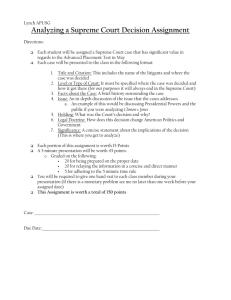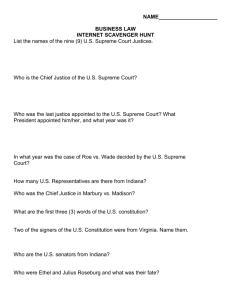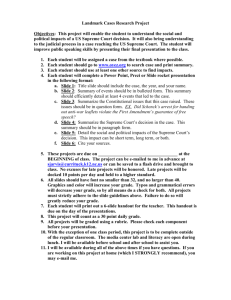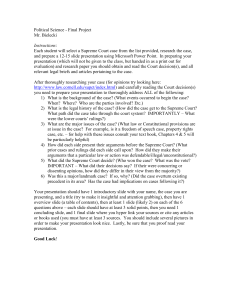Analyzing a Supreme Court Case Ms. Miller United States History I
advertisement
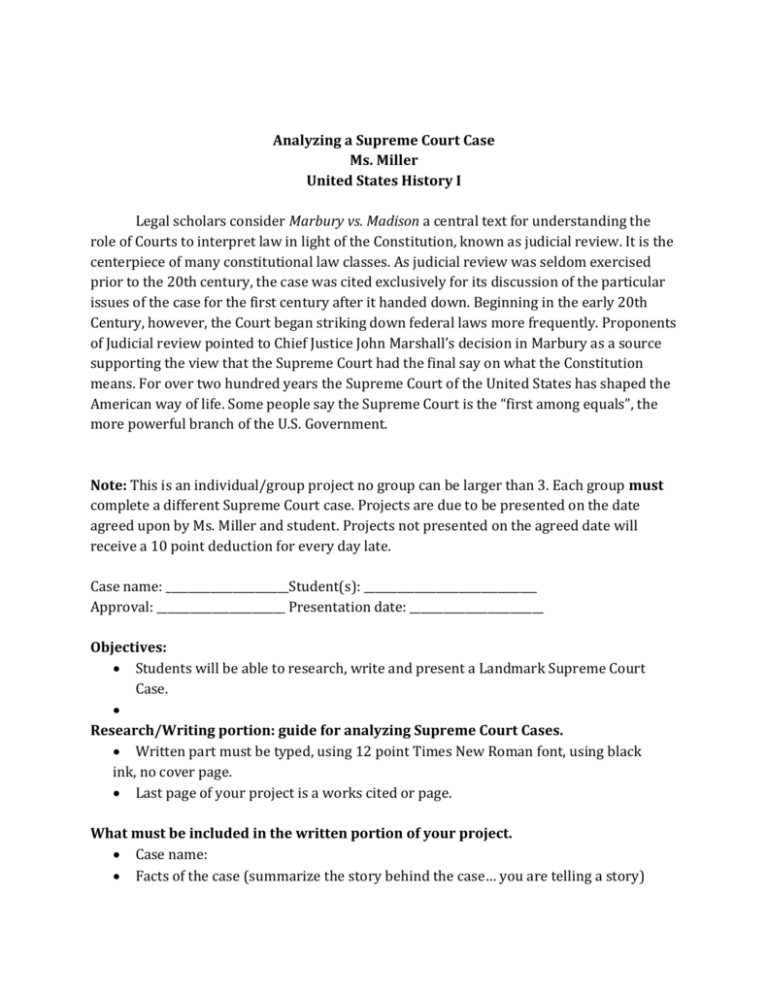
Analyzing a Supreme Court Case Ms. Miller United States History I Legal scholars consider Marbury vs. Madison a central text for understanding the role of Courts to interpret law in light of the Constitution, known as judicial review. It is the centerpiece of many constitutional law classes. As judicial review was seldom exercised prior to the 20th century, the case was cited exclusively for its discussion of the particular issues of the case for the first century after it handed down. Beginning in the early 20th Century, however, the Court began striking down federal laws more frequently. Proponents of Judicial review pointed to Chief Justice John Marshall’s decision in Marbury as a source supporting the view that the Supreme Court had the final say on what the Constitution means. For over two hundred years the Supreme Court of the United States has shaped the American way of life. Some people say the Supreme Court is the “first among equals”, the more powerful branch of the U.S. Government. Note: This is an individual/group project no group can be larger than 3. Each group must complete a different Supreme Court case. Projects are due to be presented on the date agreed upon by Ms. Miller and student. Projects not presented on the agreed date will receive a 10 point deduction for every day late. Case name: ______________________Student(s): _______________________________ Approval: _______________________ Presentation date: ________________________ Objectives: Students will be able to research, write and present a Landmark Supreme Court Case. Research/Writing portion: guide for analyzing Supreme Court Cases. Written part must be typed, using 12 point Times New Roman font, using black ink, no cover page. Last page of your project is a works cited or page. What must be included in the written portion of your project. Case name: Facts of the case (summarize the story behind the case… you are telling a story) What court or courts heard this case before the U.S. Supreme Court (name each court and verdict) What were the arguments for the plaintiff? What were the arguments for the defendant? What decision did the court make? Describe the majority opinion Describe the dissenting opinion… Did this case change/add to/take from the Constitution or any of the Amendments? If so, how? Explain fully. Does this case remain relevant or has it been superseded by another case? If it has been superseded, name the case and tell how your case changed the preceding case? Graphic portion: Project must have a visual or graphic that will contribute to your presentation. Something like a tri-fold describing the history of the case with photos and a timeline would be appropriate. Be creative, make your graphic professional looking. Presentation portion: In the PowerPoint presentation of your case the student must be knowledgeable about your case. Is your information correct? Presentation time: 8-12 minutes Remember you are preparing to tell the story of your case. You are informing your classmates about a Supreme Court Case and they probably know very little about your case. Grading Rubric for Analyzing Supreme Court Cases. Every project will be graded using this rubric. Potential Supreme Court Cases 1. Brown v Board of Education, 1954 2. Bush v Gore (2000) 3. California v Acevedo (1991) 4. Dennis v. United States (1951) 5. Dred Scott v Sandford (1857) 6. Engel v. Vitale (1962) 7. Escobedo v Illinois (1964) 8. Gideon v Wainwright (1963) (background Betts v. Brady, 1942) 9. Gitlow v New York (1923) 10. Gonzales v Raich (2005) 11. Greedwood v California (1988) 12. Gregg v Georgia, 1976 13. Hazelwood School District v Kuhlmeier (1988) 14. Katz v United States, 1967 15. Korematsu v United States (1944) 16. Mapp v Ohio (1961) 17. Miranda v Arozona (1966) 18. Near v Minnesota (1931) 19. New York Times v United States (1971) 20. Olmstead v United States (1928) 21. Plessy v Ferguson (1896) 22. Powell v Alabama (1932) 23. Regents of the University of California v Bakke, 1978 24. Roe v Wade, 1973 25. Schenck v United States (1919) 26. Sheppard v Maxwell (1966) 27. Slaughterhouse cases (1873) 28. Tinker v Des Moines (1969) 29. United States v Nixon (1974) 30. Wallace v Jeffree, 1985 * There are 30 cases listed here. You may propose a Landmark Supreme Court case that is not on this listbut you must ask permission cases are assigned on a “first come first served” basis.
